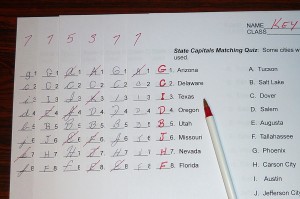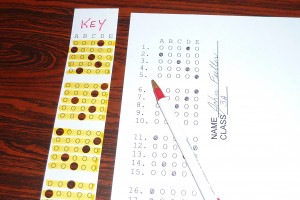Testing is as much a part of school as classrooms and homework. Without tests (or some other, obvious form of evaluation) students will get the idea that there is no responsibility for learning. Kids know that they are in school to learn even if they don’t always seem enthusiastic about it. They also know that it is your job to make them learn. If you don’t seem to be doing that, you’ll have a hard time gaining their respect. Classroom management is infinitely easier if your day is so filled with learning activities that there is simply no room for distractions and misbehavior.
The educational literature says there are four reasons for testing. I will add a fifth and enormously important one at this age.
1. Placement tests are used to determine if a student has the prerequisite skills for placement into a group or level of instruction.
2. Formative tests are given during your instructional unit to provide feedback to you and students about their progress and mastery.
3. Diagnostic tests are used to uncover and define learning difficulties.
4. Summative tests are given at the end of a unit to evaluate the level of knowledge or skill attained.
We all remember the college classes that only had two tests, the midterm and the final. It was a make or break situation. When in college, though, you were goal-oriented and presumably made the right choices. Teenagers, however, have a great many distractions in their lives. Very few will take their books home to study just for studying’s sake. They would much rather cram for the big exam than spend a few minutes a night on it for three weeks. Unfortunately, putting off studying today’s lesson often means not understanding tomorrow’s. You need to give your students frequent, short quizzes just to force them to keep up. This is the fifth reason for testing. The results on these quizzes also give you feedback on how your lesson plan is doing (formative test). It keeps you from being unpleasantly surprised by low grades on your summative test (final). If your quiz on temperature conversion shows they don’t have it yet, you can go over it again.
Since frequent quizzes are so valuable to you for these reasons, it’s probably not a good idea to restrict yourself to a rigid schedule (e.g., quiz every Friday). If, during your Tuesday question and answer period, you discover that your students don’t seem to know much about what you did on Monday, you might announce a test over that material for Wednesday.
Some teachers give unannounced quizzes, supposedly forcing students to keep up with the work. This is more likely to be productive with your more able, motivated students. Less motivated, less organized, or those students lacking in self discipline need pointed assignments from you to get them to study. “Tonight I want you to study the vocabulary words in chapter 5 in preparation for a quiz tomorrow.” For those kids, unannounced tests will more likely result in failure than increased learning.
Go to “Test Types“



